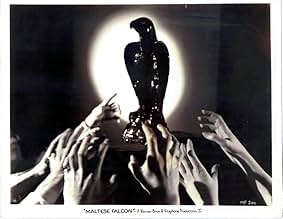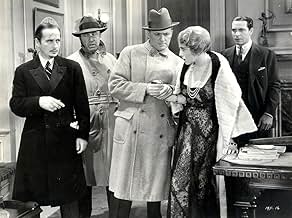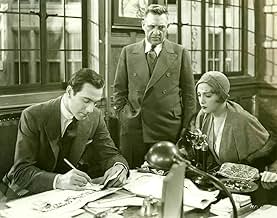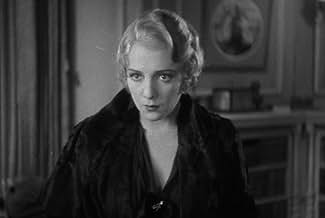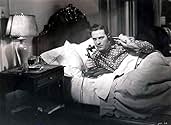Füge eine Handlung in deiner Sprache hinzuA lovely dame with dangerous lies employs the services of a private detective, who is quickly caught up in the mystery and intrigue of a statuette known as the Maltese Falcon.A lovely dame with dangerous lies employs the services of a private detective, who is quickly caught up in the mystery and intrigue of a statuette known as the Maltese Falcon.A lovely dame with dangerous lies employs the services of a private detective, who is quickly caught up in the mystery and intrigue of a statuette known as the Maltese Falcon.
- Auszeichnungen
- 2 wins total
- Capt. John Jacobi
- (Nicht genannt)
- Jailbird Seeking Cigarette
- (Nicht genannt)
- Baggage Clerk
- (Nicht genannt)
- District Attorney
- (Nicht genannt)
- Sarah - Prison Matron
- (Nicht genannt)
Empfohlene Bewertungen
DANGEROUS FEMALE is interesting in several ways, and perhaps most deeply so as an example of the struggle that ensued when sound first roared. What had proved effective on the silent screen suddenly seemed highly mannered when voices were added, and both directors and stars struggled to find new techniques--and DANGEROUS FEMALE offers a very vision of the issues involved.
It is a myth that the advent of sound forced directors to lock down the camera, but it is true that many directors preferred simple camera set-ups in early sound films; it gave them one less thing to worry about. And with this film, Roy Del Ruth is no exception: in a visual sense, DANGEROUS FEMALE is fairly static. The performing decisions made by the various actors are also illustrative and informative, particularly re leads Ricardo Cortez and Bebe Daniels. Cortez is still clearly performing in the "silent mode," and he reads as visually loud; Daniels, however, has elected to underplay, and while she is stiff by current standards, her performance must have seemed startlingly innovative at the time. And then there are two performers who are very much of the technology: Una Merkle as Spade's secretary and Thelma Todd as Iva Archer, both of whom seem considerably more comfortable with the new style than either Cortez or Daniels.
The film is also interesting as a "Pre-Code" picture, for it is sexually explicit in ways most viewers will not expect from a 1930s film, and indeed it is surprisingly explicit even in comparison to other pre-code films. Hero Sam Spade is a womanizer who seduces every attractive female who crosses his path--and the film opens with a shot of just such a woman pausing to straighten her stockings before leaving his office. Still later, the dubious Miss Wonderly tempts Spade with her cleavage, lolls in his bed after a thick night, splashes in his bathtub, and finally winds up stripped naked in his kitchen! It is also interesting, of course, to compare DANGEROUS FEMALE to its two remakes. Directed by William Dieterle and starring Warren William and Bette Davis, the 1936 Satan MET A LADY would put Hammett's plot through the wringer--and prove a critical disaster and a box office thud. But then there is the justly celebrated 1941 version starring Humphrey Bogart and Mary Astor under the direction of John Huston.
Both the 1931 and 1941 films lifted great chunks of dialogue from Hammett's novel, and very often the dialogue is line-for-line the same. But two more completely different films could scarcely be imagined. Where the 1931 film strives for an urbane quality, the 1941 film is memorably gritty--and in spite of being hampered by the production, considerably more sexually suggestive as well, implying the homosexuality of several characters much more effectively than the 1931 version dared.
In the final analysis, the 1931 THE MALTESE FALCON (aka DANGEROUS FEMALE) will appeal most to those interested in films that illustrate the transition between silent film and sound, to collectors of "pre-code" movies, and to hardcore FALCON fans who want everything associated with Hammett, his novel, and the various film versions. But I hesitate to recommend it generally; if you don't fall into one of those categories, you're likely to be unimpressed.
Gary F. Taylor, aka GFT, Amazon reviewer
Starring as Sam Spade and Miss Wonderly (who never becomes Brigid O'Shaughnessey) are Ricardo Cortez and Bebe Daniels, the talkies' first immortal guy/gal team. And joining them is the familiar ensemble of grotesques: As `Dr.' Joel Cairo, Otto Mathiessen; as Casper Gutman, Dudley Digges (who, lacking Sidney Greenstreet's girth, is never called The Fat Man); and as Wilmer the gunsel, gimlet-eyed Dwight Frye, familiar from the Dracula and Frankenstein franchises. And while Huston's cast in each instance has the edge, it's not by much these pioneering hams have a field day.
Huston trusted Hammett enough to preserve more of his astringent dialogue intact, but Dangerous Woman shows surprising fidelity to the book. The subplot about Spade's affair with his slain partner's wife Iva Archer stays prominent, and the merry widow is played by Thelma Todd (herself later to fall victim in one of Hollywood's most notorious unsolved murders). Owing to less prudish times, before the Hayes Office tried to make sex un-American, the scene is kept where Spade, in his quest for a palmed $1000 bill, makes Wonderly strip naked (though left largely off-screen). And in calling Wilmer Gutman's `boyfriend,' Spade makes a mite more explicit their old-queen/rough-trade dynamic.
Roy del Ruth, who directed, was an old newspaper man who came to Hollywood in the silent era, racking up a workmanlike list of credits (in 1949, he would return to San Francisco locales for the unusual noir Red Light). He adds some deft touches, as when, after Spade departs with her bankroll, Wonderly blithely extracts a fat wad of bills from her stocking. Much of what he might be credited for, however, may be inadvertent. Since the novel was published and the movie made on that critical cusp between the Roaring Twenties and Old Man Depression, an authentic period tang asserts itself Daniels' marcelled hair, for instance (not to mention the Vienna-born Cortez' being palmed off as a Latin lover).
The movie deviates from the novel in ending with a scene in the women's house of detention that manages to be simultaneously sassy and poignant. Dangerous Female offers an instructive lesson in how the various versions, with their differing tones and emphases, shed their own light and shadow on a classic American crime novel.
All the same Huston, who was working at Warner Bros. when this was made, must have liked something about this movie-- the scene where Spade first meets Joel Cairo (Otto Mattiesen, doing an excellent Peter Lorre imitation years before the fact) is repeated almost shot for shot and inflection for inflection in the Huston version, the only such case of direct inspiration I spotted here. Mattiesen, a familiar silent era character actor, sadly died not long after the film came out; had he lived he certainly could have had as interesting a talkie career as Lorre eventually did.
As in "Satan Met a Lady", the detective is made out to be a sleazy ladies' man in this movie. When we first see him, he's kissing a woman goodbye; we never actually see her face, but we see her adjusting her stocking, and when Sam returns to his office, the pillows from his couch are in disarray. He seems to be getting some from Effie as well (and I must point out that Una Merkel, as Effie, is hot, hot, hot in this movie; quite a contrast to the matronly Lee Patrick in the 1941 version).
Overall, though, this movie is still somewhat unsatisfying. I suppose if we had never seen the Bogart/Huston version, this would stand as an acceptable adaptation of Hammett's novel (by the standards of the time). It follows the novel fairly closely, but skimps on the plot somewhat. The subplot where Wonderley disappears, and then reappears (as O'Shaughnessy) because she realizes Gutman is in town is missing, as is all the great interplay between Spade and Wilmer ("Just keep riding me, buster", "This'll put you in solid with your boss", etc.) that was such a treat in the later version. True, this movie is a little more explicit about the relationship between Gutman and Wilmer, but Wilmer is such a minor character (with literally only a few minutes of screen time) that their relationship still seems more fully-developed in the 1941 movie. There's also a very odd change at the end (just before the prison scene) that seems like something of a cop-out.
And, finally, it must be pointed out that Ricardo Cortez really stinks in this movie. He spends most of the movie with a smirk plastered on his face, and his performance in general is extremely stiff. I suppose that's to be expected in such an early talkie, but, combined with the general aura of sleaziness that his character exudes, it makes it impossible to really care what happens to him. In the end, this is an enjoyable movie, but mainly for reasons of historical curiosity, and it never comes anywhere near the "classic" status that the later remake has achieved.
Wusstest du schon
- WissenswertesArt director Robert M. Haas performed the same function on Die Spur des Falken (1941).
- PatzerThe same prop is used for the suitcase that Spade finds in Miss Wonderly's room and the suitcase which contains the falcon. The travel stickers are identical on each one.
- Zitate
Effie Perrine: Sam, it's a gorgeous new customer.
Sam Spade: Gorgeous?
Effie Perrine: A knockout.
Sam Spade: Send her right in, honey.
Effie Perrine: [to the off-screen customer] Will you step in, please?
[Joel Cairo walks in.]
- VerbindungenFeatured in Great Performances: Bacall on Bogart (1988)
Top-Auswahl
- How long is The Maltese Falcon?Powered by Alexa
Details
- Erscheinungsdatum
- Herkunftsland
- Sprachen
- Auch bekannt als
- Dangerous Female
- Drehorte
- Produktionsfirma
- Weitere beteiligte Unternehmen bei IMDbPro anzeigen
- Laufzeit
- 1 Std. 20 Min.(80 min)
- Farbe

